|
|
Apartments in Florence, Perugia, Rome, Sorrento and Positano |




|
|
|
|
- You are in: Home » Veneto » Venice
VISIT VENICE
« All the regions
PIAZZA SAN MARCO
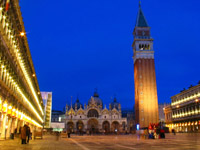
Piazza San Marco has always been the center of the city. It was called Piazza instead of Campo because even in its name it had to be unique. At the beginning of the 9th century the Piazza was much smaller. At the end of the 12th century the political and commercial power of Venice had become far stronger. Then the Venetians felt the need to give a richer aspect to their Piazza. At the beginning of the 15th century Mauro Codussi started building the Procuratie Vecchie, the buildings that go down the left side with two floors with loggias. The work was continued under the direction of Bartolomeo Bon in 1512; Jacopo Sansovino completed the bottom end in 1532. The Piazza came to be what it was when Gentile Bellini drew it in his famous painting of the "Procession of the Cross" - Accademy Gallery. The buildings that go down the right side are called Procuratie Nuove and they were completed in 1640 by Baldassare Longhena. The third side of the Piazza looking towards the Church of St. Mark was occupied by the Church of San Geminiano (the façade had been rebuilt in the 16th cent.). On the side of the Procuratie Vecchie close to the Church of St. Mark stands the Clock Tower, a fine Renaissance building with coloured enamels and gold: the central part was built after designs by Mauro Codussi (1496-99); the side wings were added between 1500 and 1506. The Campanile (the Bell Tower, 98.60 metres high) stands isolated, by the side of the Church of St. Mark.
top
SAN MARCO CATHEDRAL
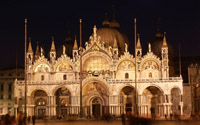
The Basilica of St. Mark is the most important monument in the city. It functioned once as Ducal Chapel. The story of the Basilica began in 828, when the body of St. Mark the Evangelist was brought there and very soon the building of a new church was started to honour the Saint, whom the Venetians acclaimed as the new patron and symbol of their city, in place of the Greek Saint Theodore. Thus the first Church of St. Mark arose and was consacrated in 832. The third Church of St. Mark (the present Basilica) was begun under the reign of doge Domenico Contarini, about 1063 and was solemnly consecrated in 1094. The Basilica of St. Mark is considered the most solemn monument of Venetian-Byzantine art ever built, until the middle of the 13th century. The 14th century has left traces of the considerable works of restoration which may be seen especially in that daring and fanciful Gothic crown to the façade, of pinnacles, kiosks and crockets. On April 7th 1529, when the fabric was much perished statically from fires and probably from negligence, it was entrusted to the intelligent care of the famous Tuscan architect Jacopo Sansovino. He gave his attention, on one hand to the strenghtening of the external walls and the cupolas which, for many years in danger of crumbling, had been shored up with supports, and on the other hand to the enriching of the fane with the new sculptures and mosaics. With the 17th century the period of the most notable changes and additions closes: it was then that the patient work of preserving, strenghtening and protecting began.
top
DOGE'S PALACE
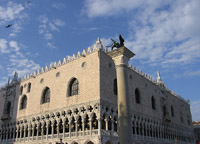
The Palazzo Ducale is perhaps the finest of all secular Gothic buildings. The palace's two magnificient Gothic façades in white Istrian stone and pink Veronese marble face the water and the Piazzetta San Marco. The palace was far more than the residence of the doge - it was the home of all of Venice's governing councils, its law courts, and even its prisons. All power in the Repubblica Serenissima (Most Serene Republic) - or La Serenissima as Venice is known to its own - was controlled within this one building. The first Palazzo Ducale was built in the ninth century. The first Ducal Chapel was erected only a few years later. Much of the building was damaged by fire in 1577, but it was successfully restored by Antonio da Ponte (who also designed the Ponte di Rialto). The interior of the Palazzo Ducale with its ducal apartments, and its rooms used by all of Venice's arms of government, houses an incredible array of works by Sansovino, Tintoretto and Veronese. In the palace's courtyard you can admire the Antonio Rizzo's magnificient marble Scala dei Giganti (Giants' Staircase), topped by statues of Mars and Neptune by Sansovino (1566).
top
SAN GIORGIO CATHEDRAL
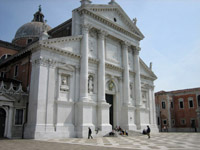
The island of San Giorgio already had a church in the 9th century, and a Benedictine monastery was founded in 982. The monks drained the marshes of the island, and the monastery was destroyed by an earthquake in 1223. Palladio designed the "Basilica di Sang Giorgio" and work began in 1566. The master did not live to see the building completed, but ever since, it has been a typical building for Venice, and a defining element of the horizontal skyline as seen from San Marco square. The island also boasts a small port, was home to the Venetian artillery, and even has a theatre. The church has paintings inside, mostly by Tintoretto, and a choir with nicely carved wooden benches. But the main attraction to see is the campanile or bellfry. The views over the city, San Marco, the canals, the bridges, the islands, San Giorgio itself, the theatre, Giudecca, the many ships sailing the Venetian waters: you can easily spend a long time watching Venetian life go by at your feet.
top
CATHEDRAL SANTA MARIA DELLA SALUTE
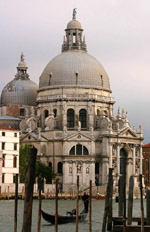
The Basilica di Santa Maria della Salute (Basilica of St Mary of Health/Salvation), commonly known simply as the Salute, is one of the largest churches of Venice and has the status of a minor basilica. It stands at the junction between the Grand Canal and the Bacino di San Marco on the lagoon. In October 1630, the Senate decreed that if the city was delivered from the currently raging plague that had killed about a third of Venice's population, then a new church would be built and dedicated to the Virgin Mary. Baldassare Longhena, then only 26 years old, was selected to design the new church. It was finally completed in 1681, the year before Longhena's death. The Salute is a vast, octagonal building, constructed of Istrian stone and marmorino (brick covered with marble dust). While its external decoration and location capture the eye, the internal design itself is quite remarkable. The octagonal church, while ringed by a classic vocabulary, hearkens to Byzantine designs such as the Basilica of San Vitale. The interior has its architectural elements demarcated by the coloration of the material, and the central nave with its ring of saints atop a balustrade is a novel design. It is full of Marian symbolism - the great dome represents her crown, the cavernous interior her womb, the eight sides the eight points on her symbolic star. The most represented artist is Titian, who painted St Mark enthroned with SS Cosmas, Damian, Sebastian and Roch, the altarpiece of the great sacristy, as well as ceiling paintings of David and Goliath, Abraham and Isaac and Cain and Abel.
top
CATHEDRAL SANTA MARIA DEI FRARI
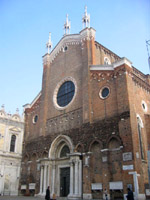
The Basilica di Santa Maria Gloriosa dei Frari, usually just called the Frari, is one of the greatest churches of Venice and has the status of a minor basilica. It stands on the Campo dei Frari at the heart of the San Polo district of the city. The church is dedicated to the Assumption (Assunzione della Beata Virgine). The Franciscans were granted land to build a church in 1250, but the building was not completed until 1338. Work almost immediately began on its much larger replacement, the current church, which took over a century to build. The campanile, the second tallest in the city after that of San Marco, was completed in 1396. The imposing church is built of brick in the Italian Gothic style. As with many Venetian churches, the exterior is rather plain. The interior contains the only rood screen still in place in Venice. The Frari is a parish church of the Vicariate of San Polo-Santa Croce-Dorsoduro. The other churches of the parish are San Barnaba, San Ludovico Vescovo, Santa Maria del Soccorso and Santa Margherita.
top
RIALTO BRIDGE
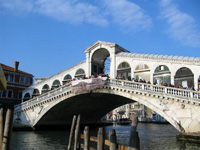
The Rialto Bridge ("Ponte di Rialto") spans the Grand Canal in Venice. It is the oldest bridge across the canal and probably the most famous in the city. The first dry crossing of the Grand Canal was a pontoon bridge built in 1181 by Nicolò Barattieri. It was called the Ponte della Moneta, presumably because of the mint that stood near its eastern entrance. The development and importance of the Rialto market on the eastern bank increased traffic on the floating bridge. So it was replaced around 1250 by a wooden bridge. The connection with the market eventually led to a change of name for the bridge. The idea of rebuilding the bridge in stone was first proposed in 1503. Several projects were considered over the following decades. In 1551 the authorities requested proposals for the renewal of the Rialto Bridge, among other things. The present stone bridge, a single span designed by Antonio da Ponte, was finally completed in 1591. It is remarkably similar to the wooden bridge it succeeded. Two inclined ramps lead up to a central portico. On either side of the portico the covered ramps carry rows of shops. The engineering of the bridge was considered so audacious that architect Vincenzo Scamozzi predicted future ruin. The bridge has defied its critics to become one of the architectural icons of Venice.
top
ACCADEMIA GALLERY
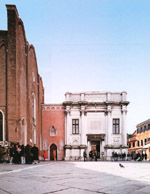
The Accademia di Belle Arti is Venice’s school of art and is uniformly known throughout Venice as the Accademia. Situated on the south bank of the Grand Canal, it gives its name to one of the three bridges across the canal, the Ponte dell'Accademia, and to the boat landing station for the vaporetto water bus. The Gallerie dell’Accademia is the home of one of the world’s greatest specialised art collections and is one of the main tourist destinations in Venice.
The Accademia was moved to its present premises in 1807 at the order of the Napoleonic occupying forces. This administration had disbanded many institutions in Venice including some churches, convents and scuole. The Scuola della CaritĂ , the Convento dei Canonici Lateranensi and the Church of Santa Maria della CaritĂ thus became the home of the Accademia. The Scuola della CaritĂ was the oldest of the six Scuole Grande and the building dates back to 1343, though the scuola was formed in 1260. The Convento dei Canonici Lateranensi was started in 1561 by Palladio, though it was never fully completed. Santa Maria della CaritĂ dates from 1441 by Bartolomeo Bon.
top
|
|
|
|
|
|
| TOP DESTINATIONS
|
| Adria Coast, Aeolian Islands, Alessandria, Altopiano Delle Rocche, Amalfi Coast, Aosta, Assisi, Asti, Bari, Brescia, Capo Vaticano, Capri, Catanzaro, Chianti, Cilento, Cinque Terre, Coast Of Marche, Conero Coast, Dolomites, Egadi Islands, Elba, Florence, Garda Lake, Gargano, Ischia, Italian Riviera, Lake Como , Langhe Piedmont, Lecce, Lucca, Lunigiana, Macerata, Mantova, Maremma Tuscany, Monferrato, Montepulciano, Naples, Perugia, Pesaro Urbino, Pisa, Pistoia, Positano, Prato, Procida, Riviera Of Palms, Rome, Salento Coast, Salerno, San Gimignano, Sardinia, Sicily, Siena, Sorrento, Terni, Tiber Valley Of Tuscany, Treviso, Turin, Val Gandino, Veneto, Venice, Viterbo |
|
|












